Pecharsky V.K., Zavalij P.Y. Fundamentals of Powder Diffraction and Structural Characterization of Materials
Подождите немного. Документ загружается.

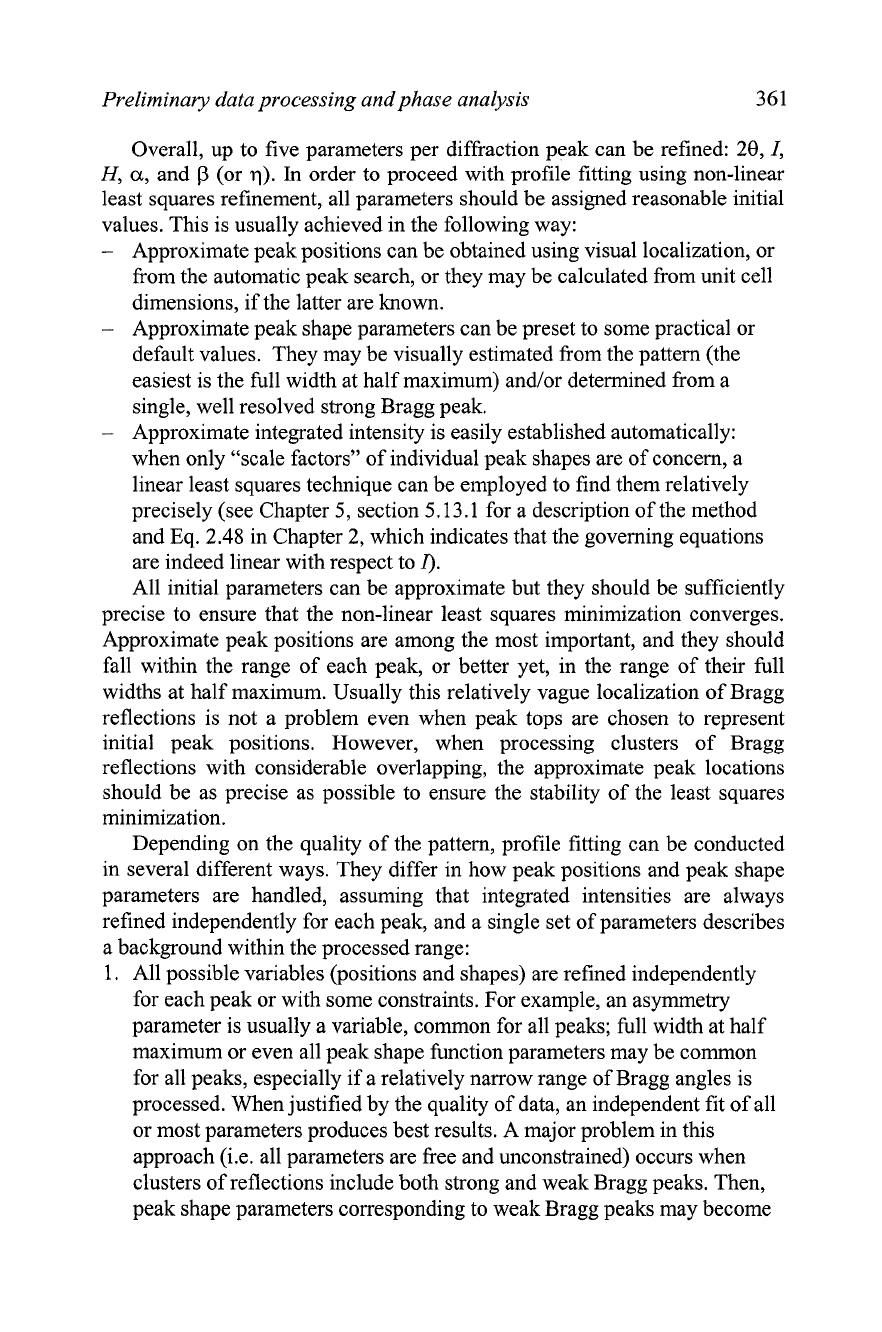
Preliminary data processing and phase analysis
361
Overall, up to five parameters per diffraction peak can be refined: 28,
I,
H,
a,
and
p
(or
q).
In
order to proceed with profile fitting using non-linear
least squares refinement, all parameters should be assigned reasonable initial
values. This is usually achieved in the following way:
-
Approximate peak positions can be obtained using visual localization, or
from the automatic peak search, or they may be calculated from unit cell
dimensions, if the latter are known.
-
Approximate peak shape parameters can be preset to some practical or
default values. They may be visually estimated from the pattern (the
easiest is the full width at half maximum) andlor determined from a
single, well resolved strong Bragg peak.
-
Approximate integrated intensity is easily established automatically:
when only "scale factors" of individual peak shapes are of concern, a
linear least squares technique can be employed to find them relatively
precisely (see Chapter 5, section
5.13.1 for a description of the method
and Eq. 2.48 in Chapter 2, which indicates that the governing equations
are indeed linear with respect to
I).
All initial parameters can be approximate but they should be sufficiently
precise to ensure that the non-linear least squares minimization converges.
Approximate peak positions are among the most important, and they should
fall within the range of each peak, or better yet, in the range of their full
widths at half maximum. Usually this relatively vague localization of Bragg
reflections is not a problem even when peak tops are chosen to represent
initial peak positions. However, when processing clusters of Bragg
reflections with considerable overlapping, the approximate peak locations
should be as precise as possible to ensure the stability of the least squares
minimization.
Depending on the quality of the pattern, profile fitting can be conducted
in several different ways. They differ in how peak positions and peak shape
parameters are handled, assuming that integrated intensities are always
refined independently for each peak, and a single set of parameters describes
a background within the processed range:
1. All possible variables (positions and shapes) are refined independently
for each peak or with some constraints. For example, an asymmetry
parameter is usually a variable, common for all peaks; full width at half
maximum or even all peak shape function parameters may be common
for all peaks, especially if a relatively narrow range of Bragg angles is
processed. When justified by the quality of data, an independent fit of all
or most parameters produces best results. A major problem in this
approach
(i.e. all parameters are free and unconstrained) occurs when
clusters of reflections include both strong and weak Bragg peaks. Then,
peak shape parameters corresponding to weak Bragg peaks may become
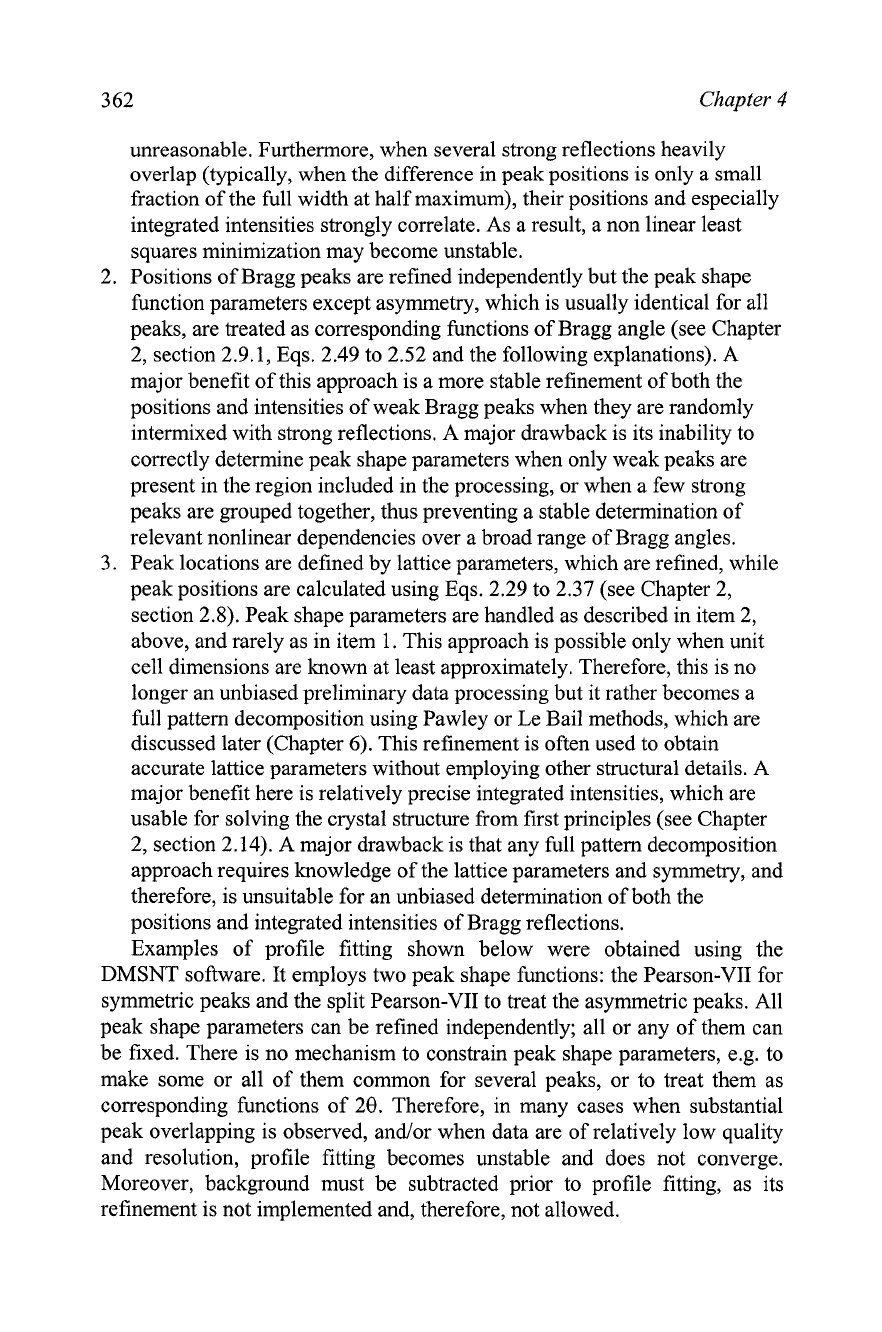
3 62
Chapter
4
unreasonable. Furthermore, when several strong reflections heavily
overlap (typically, when the difference in peak positions is only a small
fraction of the full width at half maximum), their positions and especially
integrated intensities strongly correlate. As a result, a non linear least
squares minimization may become unstable.
2. Positions of Bragg peaks are refined independently but the peak shape
function parameters except asymmetry, which is usually identical for all
peaks, are treated as corresponding functions of Bragg angle (see Chapter
2, section 2.9.1, Eqs. 2.49 to 2.52 and the following explanations). A
major benefit of this approach is a more stable refinement of both the
positions and intensities of weak Bragg peaks when they are randomly
intermixed with strong reflections. A major drawback is its inability to
correctly determine peak shape parameters when only weak peaks are
present in the region included in the processing, or when a few strong
peaks are grouped together, thus preventing a stable determination of
relevant nonlinear dependencies over a broad range of Bragg angles.
3. Peak locations are defined by lattice parameters, which are refined, while
peak positions are calculated using Eqs. 2.29 to 2.37 (see Chapter 2,
section 2.8). Peak shape parameters are handled as described in item 2,
above, and rarely as in item
1.
This approach is possible only when unit
cell dimensions are known at least approximately. Therefore, this is no
longer an unbiased preliminary data processing but it rather becomes a
full pattern decomposition using
Pawley or Le Bail methods, which are
discussed later (Chapter
6).
This refinement is often used to obtain
accurate lattice parameters without employing other structural details.
A
major benefit here is relatively precise integrated intensities, which are
usable for solving the crystal structure from first principles (see Chapter
2, section 2.14). A major drawback is that any full pattern decomposition
approach requires knowledge of the lattice parameters and symmetry, and
therefore, is unsuitable for an unbiased determination of both the
positions and integrated intensities of Bragg reflections.
Examples of profile fitting shown below were obtained using the
DMSNT software. It employs two peak shape functions: the Pearson-VII for
symmetric peaks and the split Pearson-VII to treat the asymmetric peaks. All
peak shape parameters can be refined independently; all or any of them can
be fixed. There is no mechanism to constrain peak shape parameters,
e.g. to
make some or all of them common for several peaks, or to treat them as
corresponding functions of 28. Therefore, in many cases when substantial
peak overlapping is observed,
and/or when data are of relatively low quality
and resolution, profile fitting becomes unstable and does not converge.
Moreover, background must be subtracted prior to profile fitting, as its
refinement is not implemented and, therefore, not allowed.
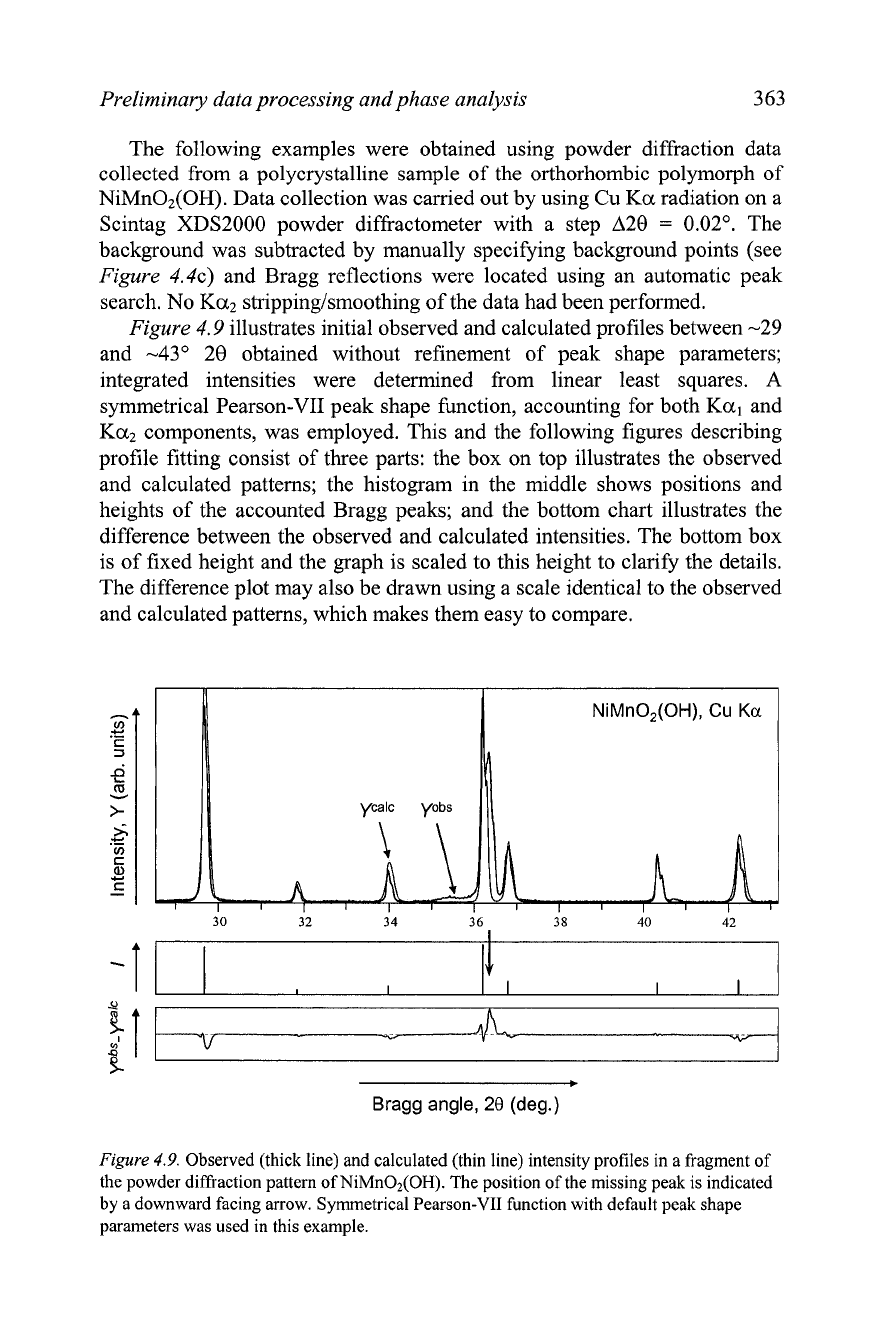
Preliminary data processing and phase analysis
3 63
The following examples were obtained using powder diffraction data
collected from a polycrystalline sample of the orthorhombic polymorph of
NiMn02(OH). Data collection was carried out by using Cu Ka radiation on a
Scintag XDS2000 powder diffiactometer with a step A20
=
0.02". The
background was subtracted by manually specifying background points (see
Figure
4.4~) and Bragg reflections were located using an automatic peak
search. No Ka2 strippinglsmoothing of the data had been performed.
Figure
4.9 illustrates initial observed and calculated profiles between -29
and -43" 28 obtained without refinement of peak shape parameters;
integrated intensities were determined from linear least squares.
A
symmetrical Pearson-VII peak shape function, accounting for both Kal and
Ka2 components, was employed. This and the following figures describing
profile fitting consist of three parts: the box on top illustrates the observed
and calculated patterns; the histogram in the middle shows positions and
heights of the accounted Bragg peaks; and the bottom chart illustrates the
difference between the observed and calculated intensities. The bottom box
is of fixed height and the graph is scaled to this height to clarify the details.
The difference plot may also be drawn using a scale identical to the observed
and calculated patterns, which makes them easy to compare.
Bragg angle,
28
(deg.)
Figure
4.9.
Observed (thick line) and calculated (thin line) intensity profiles in a fragment of
the powder diffraction pattern of NiMn02(0H). The position of the missing peak is indicated
by a downward facing arrow. Symmetrical Pearson-VII function with default peak shape
parameters was used in this example.
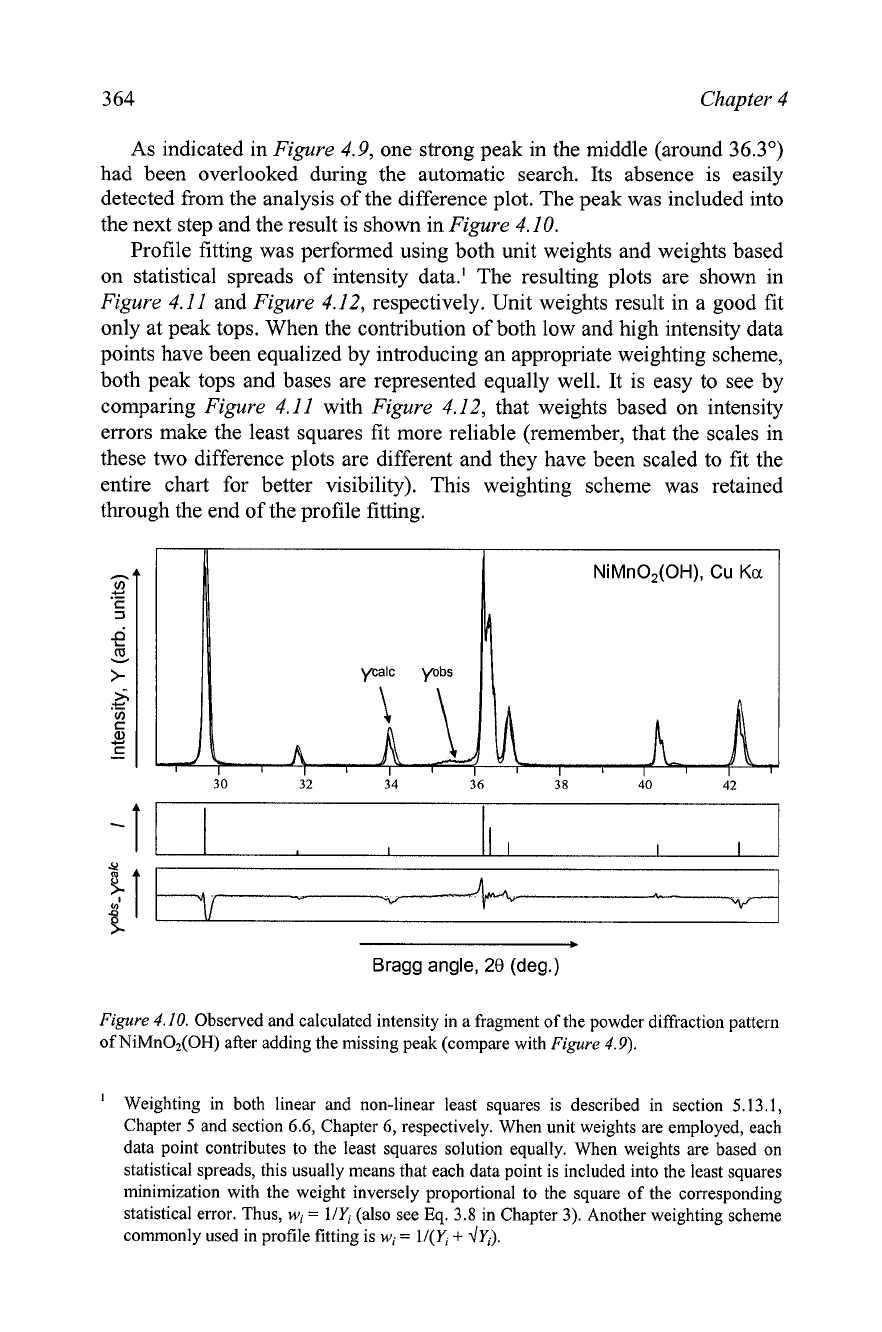
3 64
Chapter
4
As indicated in
Figure
4.9, one strong peak in the middle (around 36.3')
had been overlooked during the automatic search. Its absence is easily
detected from the analysis of the difference plot. The peak was included into
the next step and the result is shown in
Figure
4.10.
Profile fitting was performed using both unit weights and weights based
on statistical spreads of intensity data.' The resulting plots are shown in
Figure
4.11 and
Figure
4.12, respectively. Unit weights result in a good fit
only at peak tops. When the contribution of both low and high intensity data
points have been equalized by introducing an appropriate weighting scheme,
both peak tops and bases are represented equally well. It is easy to see by
comparing
Figure
4.11 with
Figure
4.12, that weights based on intensity
errors make the least squares fit more reliable (remember, that the scales in
these two difference plots are different and they have been scaled to fit the
entire chart for better visibility). This weighting scheme was retained
through the end of the profile fitting.
Bragg angle,
28
(deg.)
Figure
4.10.
Observed and calculated intensity in a fragment of the powder diffraction pattern
of NiMn02(OH) after adding the missing peak (compare with
Figure
4.9).
Weighting in both linear and non-linear least squares is described in section
5.13.1,
Chapter
5
and section
6.6,
Chapter
6,
respectively. When unit weights are employed, each
data point contributes to the least squares solution equally. When weights are based on
statistical spreads, this usually means that each data point is included into the least squares
minimization with the weight inversely proportional to the square of the corresponding
statistical error. Thus,
wi
=
14 (also see Eq. 3.8 in Chapter
3).
Another weighting scheme
commonly used in profile fitting is
wi
=
1/(K
+
d~).
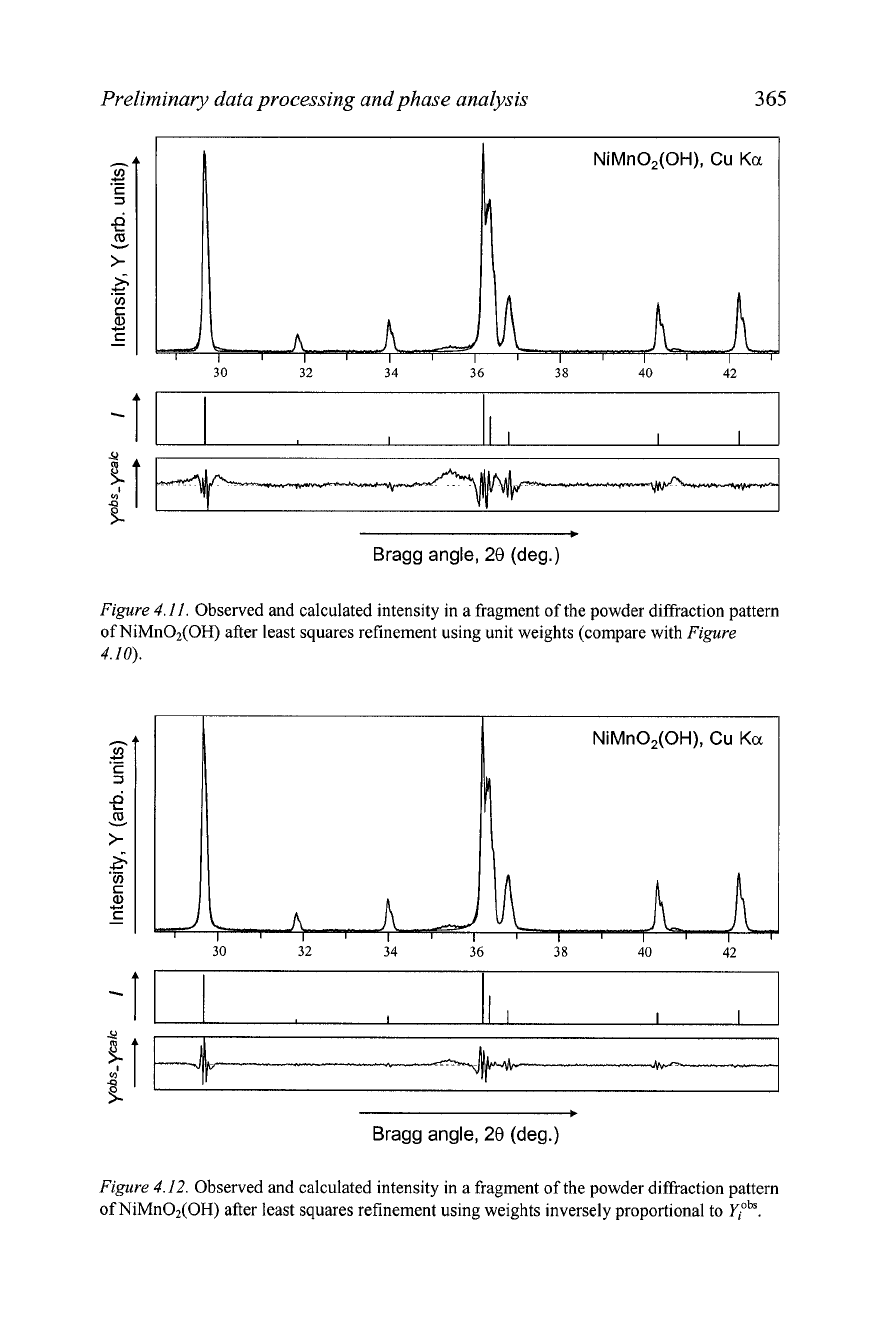
Preliminary data processing and phase analysis
365
Bragg angle,
28
(deg.)
Figure
4.11.
Observed and calculated intensity in a fragment of the powder diffraction pattern
of NiMn02(OH) after least squares refinement using unit weights (compare with
Figure
4.10).
Bragg angle,
20
(deg.)
Figure
4.12.
Observed and calculated intensity in a fragment of the powder diffraction pattern
of NiMnO,(OH) after least squares refinement using weights inversely proportional to
yiobs.
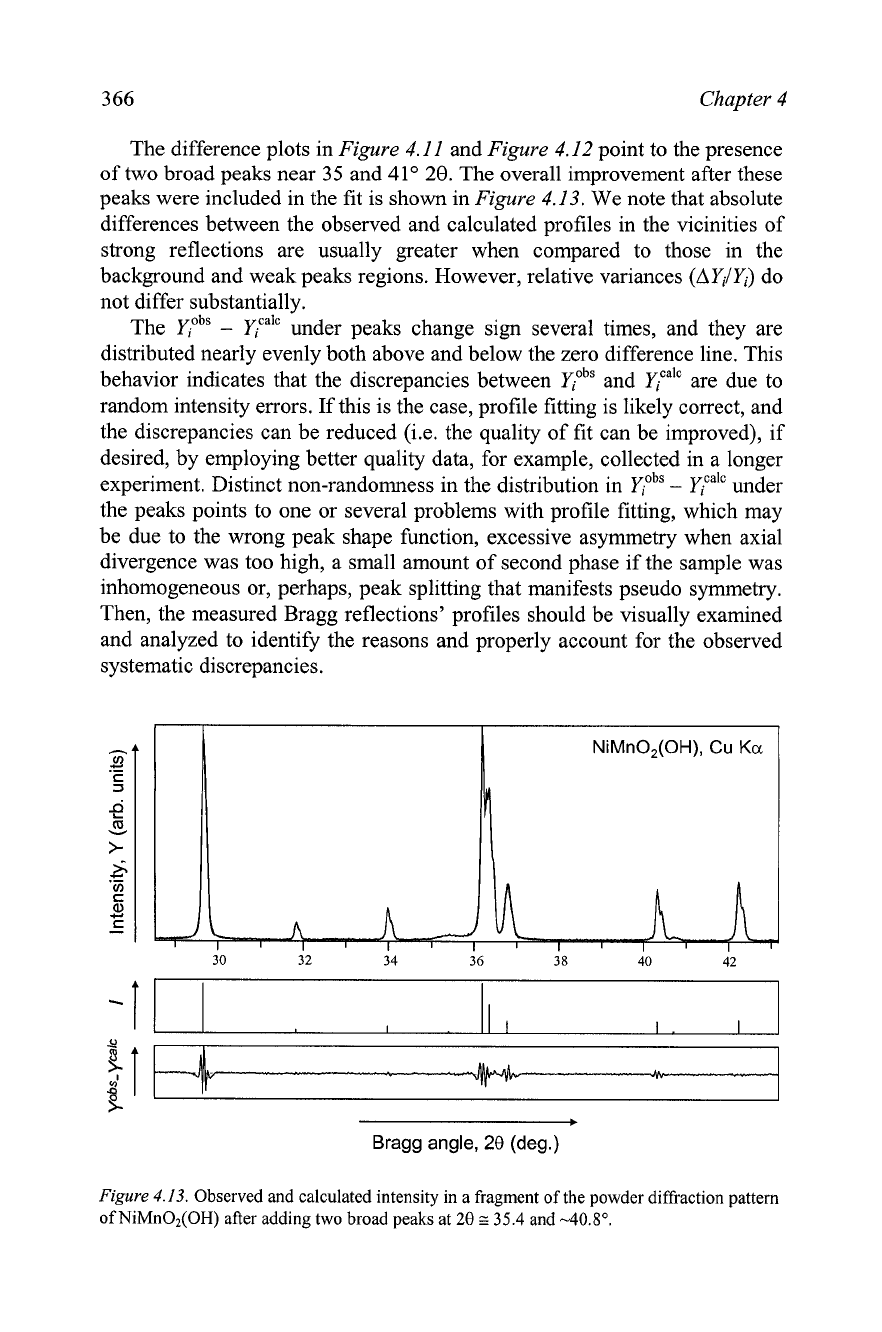
3
66
Chapter
4
The difference plots in
Figure
4.11
and
Figure
4.12
point to the presence
of two broad peaks near
35
and
41"
20.
The overall improvement after these
peaks were included in the fit is shown in
Figure
4.13.
We note that absolute
differences between the observed and calculated profiles in the vicinities of
strong reflections are usually greater when compared to those in the
background and weak peaks regions. However, relative variances
(AYi/&)
do
not differ substantially.
The
yiob"
under peaks change sign several times, and they are
distributed nearly evenly both above and below the zero difference line. This
behavior indicates that the discrepancies between
yiObS
and
Fa''
are due to
random intensity errors. If this is the case, profile fitting is likely correct, and
the discrepancies can be reduced (i.e. the quality of fit can be improved), if
desired, by employing better quality data, for example, collected in a longer
experiment. Distinct non-randomness in the distribution in
yiObS
-
ylcalc
under
the peaks points to one or several problems with profile fitting, which may
be due to the wrong peak shape function, excessive asymmetry when axial
divergence was too high, a small amount of second phase if the sample was
inhomogeneous or, perhaps, peak splitting that manifests pseudo symmetry.
Then, the measured Bragg reflections' profiles should be visually examined
and analyzed to identify the reasons and properly account for the observed
systematic discrepancies.
Bragg angle,
28
(deg.)
Figure
4.13.
Observed and calculated intensity in
a
fragment of the powder diffraction pattern
of NiMn02(OH) after adding two broad peaks at
28
z
35.4
and
-40.8'.
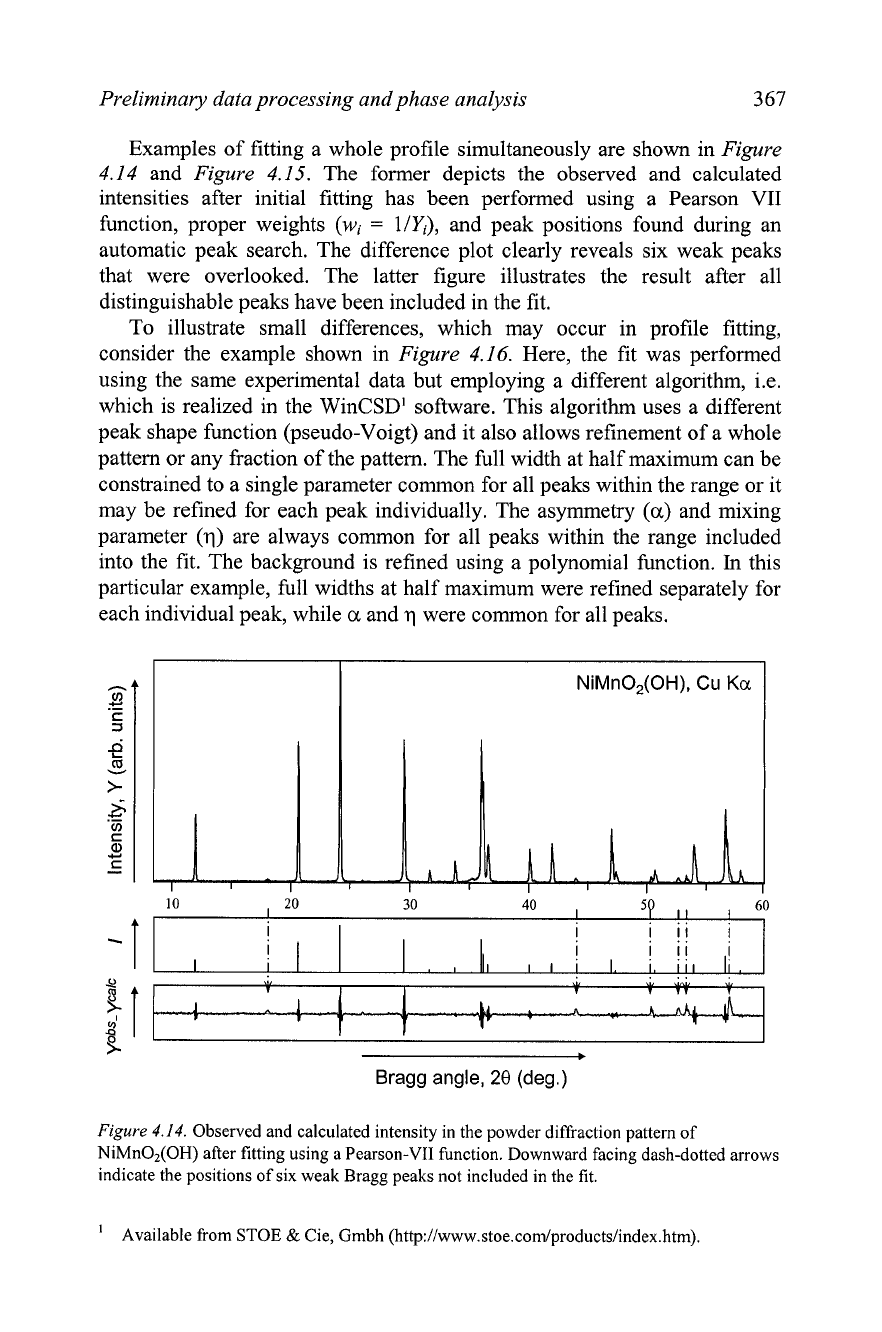
Preliminary data processing and phase analysis
367
Examples of fitting a whole profile simultaneously are shown in
Figure
4.14
and
Figure
4.15.
The former depicts the observed and calculated
intensities after initial fitting has been performed using a Pearson
VII
function, proper weights
(wi
=
l/Yi),
and peak positions found during an
automatic peak search. The difference plot clearly reveals six weak peaks
that were overlooked. The latter figure illustrates the result after all
distinguishable peaks have been included in the fit.
To illustrate small differences, which may occur in profile fitting,
consider the example shown in
Figure
4.16.
Here, the fit was performed
using the same experimental data but employing a different algorithm, i.e.
which is realized in the WinCSD1 software. This algorithm uses a different
peak shape function (pseudo-Voigt) and it also allows refinement of a whole
pattern or any fraction of the pattern. The full width at half maximum can be
constrained to a single parameter common for all peaks within the range or it
may be refined for each peak individually. The asymmetry
(a)
and mixing
parameter (q) are always common for all peaks within the range included
into the fit. The background is refined using a polynomial function.
In
this
particular example, full widths at half maximum were refined separately for
each individual peak, while
a
and q were common for all peaks.
Figure
4.14.
Observed and calculated intensity in the powder diffraction pattern of
NiMnO,(OH) after fitting using a Pearson-VII function. Downward facing dash-dotted arrows
indicate the positions of six weak Bragg peaks not included in the fit.
10
20
30
40
I
5f
60
'
Available from STOE
&
Cie, Gmbh
(http:Nwww.stoe.corn/products/index.htm).
-
T
!
I
.
.~
!
!
!!
!
! !
!!
,!
II
I
I.
1,111
1,
. ..
w
b
Bragg angle,
28
(deg.)
",
w
ww
",
I
n
..
h
1
I1
I
I
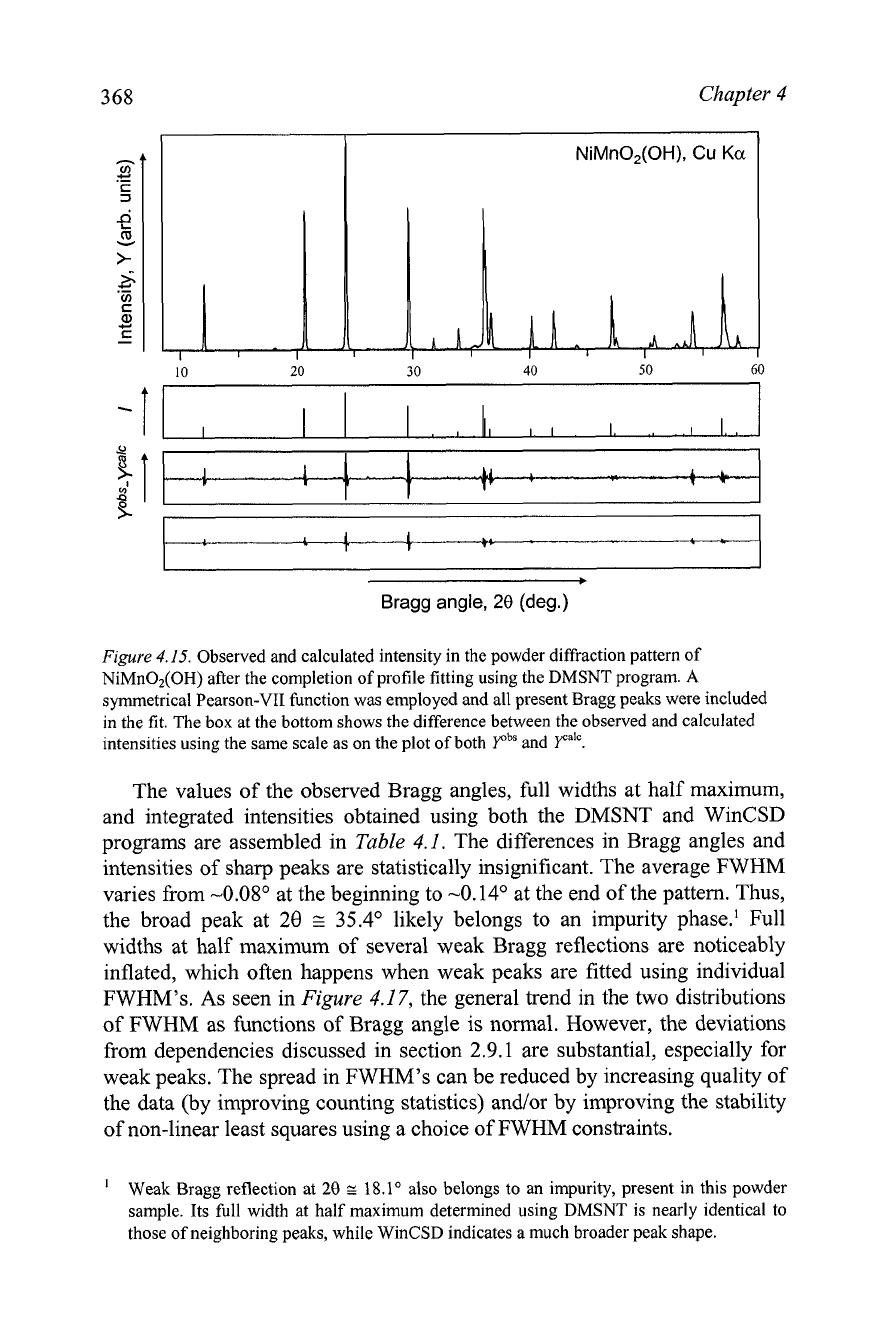
368
Chapter
4
Bragg angle,
20
(deg.)
Figure
4.15.
Observed and calculated intensity in the powder diffraction pattern of
NiMnO,(OH) after the completion of profile fitting using the DMSNT program.
A
symmetrical Pearson-VII function was employed and all present Bragg peaks were included
in the fit. The box at the bottom shows the difference between the observed and calculated
intensities using the same scale as on the plot of both
PbS
and
Yale.
The values of the observed Bragg angles, full widths at half maximum,
and integrated intensities obtained using both the DMSNT and WinCSD
programs are assembled in
Table
4.1.
The differences in Bragg angles and
intensities of sharp peaks are statistically insignificant. The average FWHM
varies from -0.08" at the beginning to -0.14' at the end of the pattern. Thus,
the broad peak at
20
E
35.4" likely belongs to an impurity phase.' Full
widths at half maximum of several weak Bragg reflections are noticeably
inflated, which often happens when weak peaks are fitted using individual
FWHM's. As seen in
Figure
4.1
7,
the general trend in the two distributions
of FWHM as functions of Bragg angle is normal. However, the deviations
from dependencies discussed in section
2.9.1
are substantial, especially for
weak peaks. The spread in FWHM's can be reduced by increasing quality of
the data (by improving counting statistics) andlor by improving the stability
of non-linear least squares using a choice of FWHM constraints.
'
Weak Bragg reflection at
20
z
18.1'
also belongs to an impurity, present in this powder
sample. Its full width at half maximum determined using DMSNT is nearly identical to
those of neighboring peaks, while
WinCSD indicates a much broader peak shape.
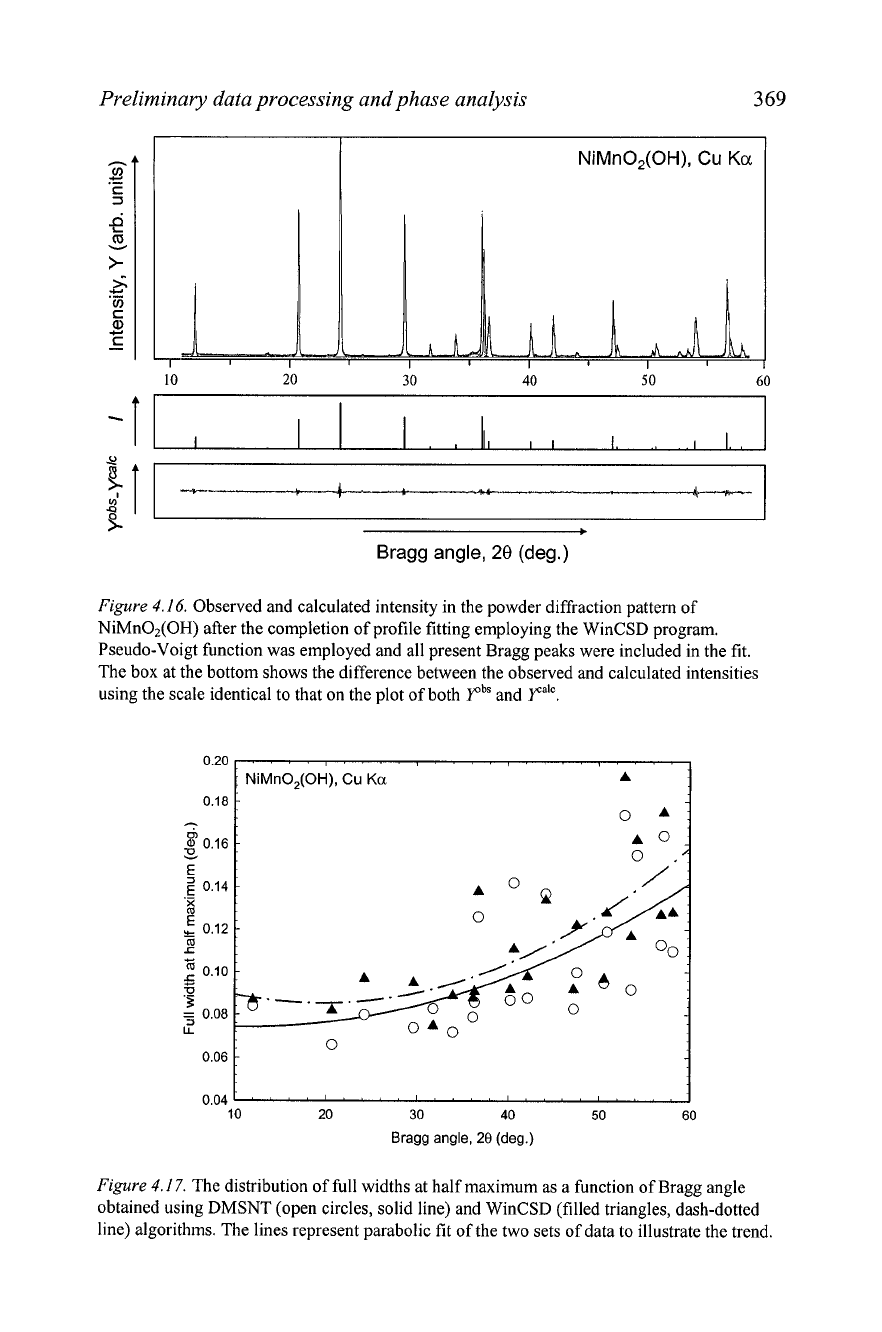
Preliminary data processing and phase analysis
3
69
Figure
4.16.
Observed and calculated intensity in the powder diffraction pattern of
NiMn02(0H) after the completion of profile fitting employing the WinCSD program.
Pseudo-Voigt function was employed and all present Bragg peaks were included in the fit.
The box at the bottom shows the difference between the observed and calculated intensities
using the scale identical to that on the plot of both
PbS
and
PalC.
,o
Bragg angle,
28
(deg.)
q
9
Figure
4.17.
The distribution of full widths at half maximum as a function of Bragg angle
obtained using DMSNT (open circles, solid line) and WinCSD (filled triangles, dash-dotted
line) algorithms. The lines represent parabolic fit of the two sets of data to illustrate the trend.
-----i-
:
1
5
b
Bragg
angle,
28
(deg.)
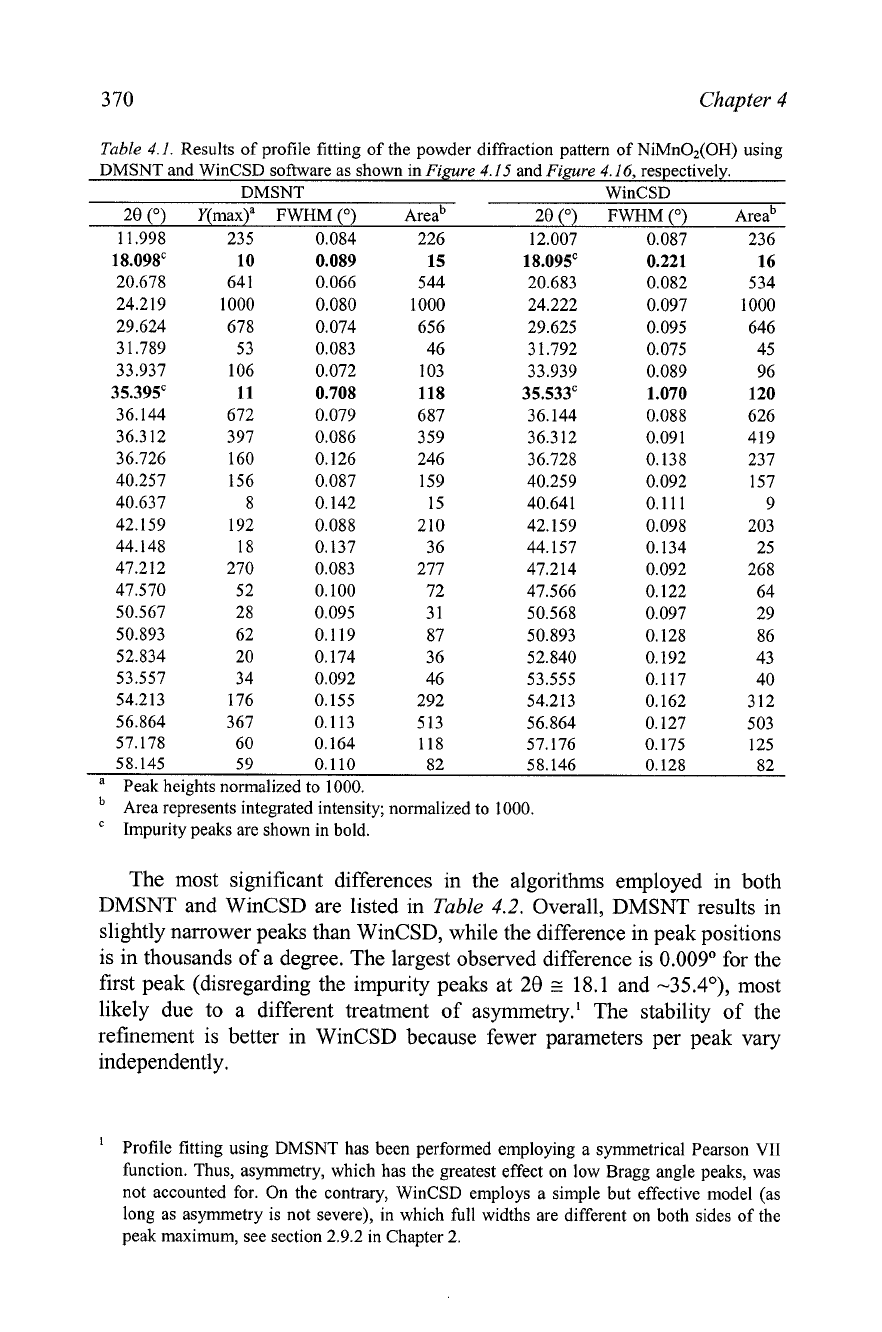
3
70
Chapter
4
Table
4.
I.
Results of profile fitting of the powder diffraction pattern of NiMn02(OH) using
DMSNT and WinCSD software as shown in
Figure
4.15
and
Figure
4.16,
respectively.
DMSNT WinCSD
20
(O)
Y(rna~)~ FWHM
(")
Areab
20
(")
FWHM
(")
Areab
58.145
5
9
0.110 82 58.146 0.128 82
a
Peak heights normalized to 1000.
Area represents integrated intensity; normalized to 1000.
'
Impurity peaks are shown in bold.
The most significant differences in the algorithms employed in both
DMSNT and WinCSD are listed in
Table
4.2.
Overall, DMSNT results in
slightly narrower peaks than WinCSD, while the difference in peak positions
is in thousands of a degree. The largest observed difference is
0.009"
for the
first peak (disregarding the impurity peaks at
28
z
18.1
and -35.4"), most
likely due to a different treatment of asymmetry.' The stability of the
refinement is better in WinCSD because fewer parameters per peak vary
independently.
Profile fitting using DMSNT has been performed employing a symmetrical Pearson VII
function. Thus, asymmetry, which has the greatest effect on low Bragg angle peaks, was
not accounted for. On the contrary, WinCSD employs a simple but effective model (as
long as asymmetry is not severe), in which full widths are different on both sides of the
peak maximum, see section
2.9.2
in Chapter
2.
